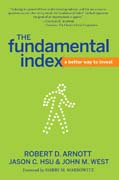
The fundamental index: a better way to invest
Arnott, Robert D.
Hsu, John C.
West, John M.
Markowitz, Harry M.
INDICE: Foreword. Preface. Chapter 1. Efficient Indexing for an InefficientMarket. Evidence of Market Efficiency. The Case for Indexing. Evidence of Market Inefficiency. Conclusion. Chapter 2. Origins of the Fundamental Index Concept. The Origins of Research Affiliates Fundamental Index (RAFI). A Series of Aha! Moments Research Affiliates Fundamental Index. Fundamental Index Performance. Concluding Thoughts: A Better Way to Invest. Chapter 3. Investors Greatest Errors. Negative Alpha. Practicing What We Preach. Conclusion. Chapter 4. The Virtues of Index Funds. The Appeal of Equity Investing. Equity Investing Choices. The One Guarantee in InvestmentsCosts Matter. Index Fund Advantages. Avoiding the Performance Game. Concluding Point. Chapter 5. The Index Fund's Achilles Heel. Market Efficiency: Two Interpretations. Constructing a Well-Functioning Index. The Achilles Heel of Cap-Weighting. The Problems with Equal Weighting. Concluding Thoughts. Chapter 6. A Fundamental(ly) Better Index. Building the Fundamental Index. Adjustments for non-dividend-paying companies. Why Multiple Measures of Company Size? Advantages of a Composite Measure. An Index of the Broad Economy. Capacity and Liquidity. Reconstituting the Fundamental Index: Keeping Turnover Low. Concluding Comments. Chapter 7. Fundamental Index Performance in U.S. Stocks. RAFI US Large Company Performance. Digging Deeper across Market Cycles. Digging Deeper into Different Time Periods. An Equal Comparison: Fundamental Index vs. Equal Weighting. Out-of-Sample Results: Small Companies. Using the Fundamental Index with Style: Growth and Value Applications. Narrowing the Focus: NASDAQ. Narrowing the Focus: REITs. Narrowing the Focus: Sector Performance. Extending the Analysis Back in Time. Conclusion. Chapter 8. Beyond Borders: Fundamental Index Performance in Global Markets. FundamentalIndex Performance in Global Markets. Multicountry Portfolios. Emerging Markets. Consistency Counts. Concluding Comments: Lessons Learned From the Global Markets. Chapter 9. Has Theory Led the Profession Astray? Will the Real Active Strategy Please Step Forward? The Origins of Cap Weighting. Apparent Validationof Cap Weighting by Theory. Forty Years Later: Empirical Results of the CAPM.Ockham's Razor Applied. Concluding Comments: Theory and the Profession. Chapter10. The Basic Criticism: Our Style and Size Tilt. Merely a Value Tilt. Small-Cap Bias. Fama and French Factors. Some Big Surprises in Small Companies. Conclusion. Chapter 11. Other Common Critiques: Hits and Misses. Mining the Data?Costs. Is It an Index? Do We Know Which Stocks Are Overvalued? How Long Can It Last? Conclusion. Chapter 12. Why Trust the Fundamental Index Concept? StockLogic. The Present vs. the Future: How Often Is Wall Street Right? Why Does Wall Street Get It Wrong? Dynamic Style and Size Exposures: When Do We Want Value and Small Cap? Show Me the Numbers. Fundamental Index Strategy vs. the Crystal Ball. Does the Fundamental Index Concept work in Bonds? Conclusion. Chapter 13. The Future for the Fundamental Index: Secular Market Considerations. What Can We (Rationally) Expect from Our Investments? Forecasting Bond Returns. Forecasting Stock Returns. The Fundamental Index Strategy in a Low-Return Environment. The Outlook for Pricing Errors. Could Pricing Errors Actually Increase? Conclusion. Chapter 14. Using the Fundamental Index. Asset Allocation and the Fundamental Index Strategy. Should We Change Our Benchmark? Diversifying thePassive Allocation. Different Markets, Different Investors, Different Needs. Conclusion. Appendix. Notes. References. Index.
- ISBN: 978-0-470-27784-3
- Editorial: John Wiley & Sons
- Encuadernacion: Cartoné
- Páginas: 304
- Fecha Publicación: 30/04/2008
- Nº Volúmenes: 1
- Idioma: Inglés
